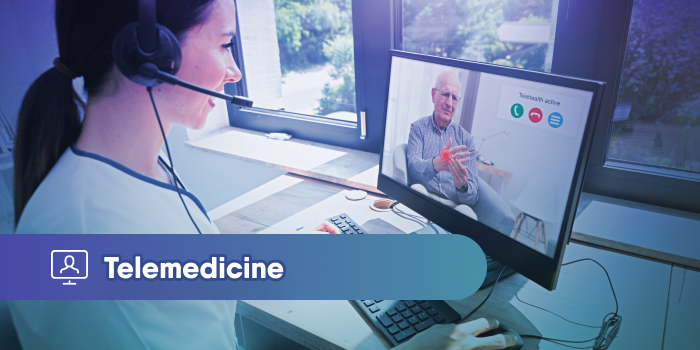Common Patient Communication Problems and How to Solve Them
Communication is the key to any great organization. How healthcare practice’s internally communicate and externally communicate with their patients...
4 min read
 Joshua Inciso
:
4/26/22 7:00 AM
Joshua Inciso
:
4/26/22 7:00 AM

One of the key elements of meaningful patient engagement is outstanding patient communication. Tools like automated patient communication simplify the process of reaching out to patients, for example, reminding them about medications or a treatment plan. Many healthcare providers use patient communication tools to contact patients who are due for a physical evaluation or to mention additional information about their next appointment.
The advantages of automated systems are widely proven in many healthcare organizations. Small clinics value automation since it allows them to provide sustainable support for patients and stay competitive at the same time. Major healthcare providers, such as hospitals or medical centers, see automation as a revenue-generating and huge cost-cutting opportunity. Without automation, medical practitioners won’t likely achieve convenient patient communication.
According to a recent SR Health by Solutionreach survey, healthcare providers are stretched thin because of the COVID-19 pandemic; automated patient communication tools may be a worthy investment for healthcare organizations to relieve their workload.
Before and during the COVID-19 surge, the researchers conducted two surveys, observing how often provider communication drives patient satisfaction. Patients did not acknowledge certain provider communication skills as contributing to patient satisfaction during COVID-19, as they did before the pandemic.
While it may seem that providers simultaneously use old types of communication methods (e.g., telephone, mail, etc.) and automated communication software during the COVID-19, the importance of these methods can reach patients at any certain age. Not every patient has computers or mobile devices that can use automated services, the effectiveness of snail mail and telephone is adequate as it still serves its purpose in delivering urgent reminders on how to keep them healthy — as it does in receiving reminders and messages from automated communication tools.
Before we discuss how automated communication technology can keep patients healthy and enhance the patient experience, let’s discuss patient communication.
Patient communication is a critical factor for medical practitioners since it has been found to result in improved cost savings, and most importantly, improved patient care. Ensuring great patient communication may help reduce unnecessary testing, expedite patient payments, encourage greater compliance with treatment, and aid in early illness diagnosis, among other benefits.
Communicating with your patients is imperative but time-consuming. Automating patient communications can help.
In many healthcare systems, it’s not uncommon for patient communication to be inconsistent and inefficient. It’s also based on the availability of doctors or healthcare staff. Maintaining patient communication also requires regular recordkeeping, which adds to workload. But with automation, healthcare providers can communicate with patients easily while lessening the time it takes.
Healthcare software like Curogram offers services to improve patient communications using automation. Curogram is a HIPAA-compliant patient communication software with 2-way text messaging — that simplifies communication between providers and patients. It may enhance your practice’s operational efficiency, resulting in more accurate information and fewer mistakes with a patient's health information.
Many patients forget about their medications and other important information about their treatment as soon as they step out of the clinic, but with automated patient communication, patients receive a message from their provider that outlines what they need to do. Thanks to patient communication tools, healthcare providers can easily keep patients healthy and on track.
Automated communication is also more cost-effective and enhances the productivity of health facilities by accurately making key operations automatic. With a growing number of patients craving great quality healthcare, professionals may be unable to keep up with the demand.
Patients want more convenient access to healthcare providers, which the use of technology offers. Automation enables medical practitioners to give their patients the on-demand access they demand, which may boost patient satisfaction and have a favorable effect on provider compensation while benefiting patients as they maintain their health.
Here are other ways automation can help patients stay healthy:
Patient no-shows are a source of frustration for medical practitioners as they cause unfilled slots in doctors’ schedules, lead to delays in treatment, and may increase the expense of healthcare. Patients are at a greater risk of developing health problems, an increased severity of symptoms, and may require more complex medical treatments in the future when they miss scheduled consultations.
Using automated patient communication tools guarantees that patients are notified about scheduled consultations. It allows patients to confirm, reschedule, or cancel their appointments.
It’s common for medical practices to assign staff to take daily patient calls. The staff encourages patients to visit the facility for an appointment, assist with prescription details, and clarify clinical concerns.
As patients don’t often answer calls, it takes a lot of time to make phone calls every day. An effective automated patient communication software such as Curogram uses secure 2-way text messaging, which enables medical staff to communicate with patients without picking up a phone but still capable of exchanging data, as required. Because of its HIPAA compliance, Curogram text conversations can cover any details about a patient’s health, from answering questions about symptoms or treatment to following up after a procedure or lab work.
Unlike any other method, text messages are seen and replied to at a higher rate and in a shorter period. So, it’s reasonable to contact patients using this communication approach, boosting the probability of a response and maintaining their health.
Automated patient communication enables healthcare providers to contact patients quickly. It takes much longer for clinic personnel to assess the patient’s concerns by making or receiving phone calls.
Patients may also schedule and change their appointments by texting, which is significantly handy for individuals with limited availability. An automated patient communication tool may provide patients with appointment availability and allow patients to choose their preferred time. It also allows patients to text their available days and times so that medical staff may schedule them more efficiently.
When patients can communicate with their healthcare provider easily, it improves health outcomes because they get the care they need.
Operating a medical practice isn’t simple, especially during the COVID-19 pandemic, but you can streamline processes with patient communication software that allows automation. While operational performance is essential, healthcare professionals must equally concentrate on providing the greatest possible patient outcomes. Fortunately, modern automation systems combine the benefits of technology with patient-centered communication.
When patients are healthy because of the services you provide, that results in patient satisfaction, which means recommendations and good feedback that may bring in new clients. In addition, pleased patients are much more likely to return to you for future appointments.
It is essential for healthcare providers to implement automation to remain competitive in today’s constantly ever-changing health industry. With automated patient communication, your practice can promote sustainable growth, which enables you to flourish and prosper. A strong emphasis on patient communication helps your practice achieve a higher status.

Communication is the key to any great organization. How healthcare practice’s internally communicate and externally communicate with their patients...

Telehealth enables patients to be more engaged with their healthcare providers as it provides them easier access and greater convenience to care.

In a demanding and competitive industry, businesses like your medical practice must consistently balance tasks to improve patient satisfaction while...